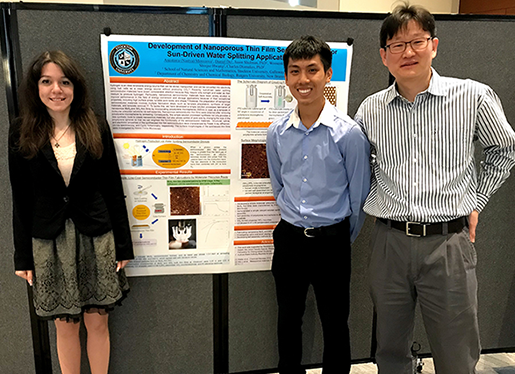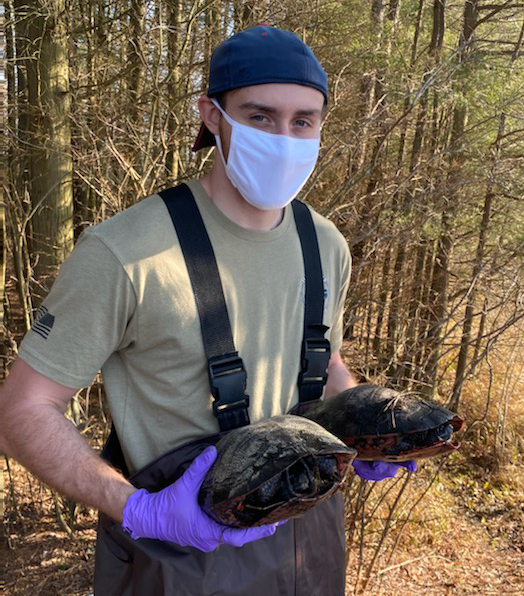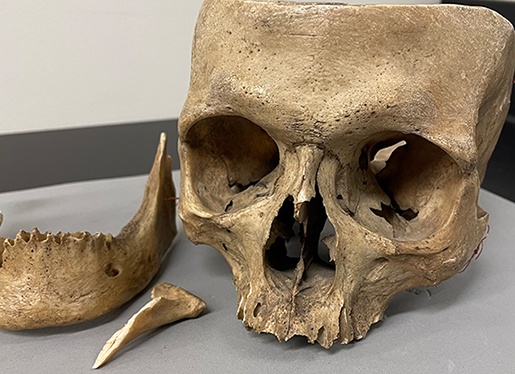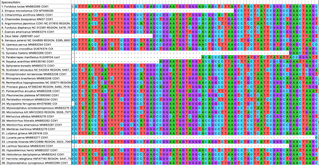NAMS Symposium



Welcome to the 2021 Virtual NAMS Symposium!
The NAMS showcase is a competition for students in the natural sciences programs to
present their research findings every spring. Due to COVID restrictions, this year's
event will take place virtually.
Students have designed their own web pages to present their work which includes a personal video, poster, abstract, and technical slide presentation. Winners and awards were announced on Friday, April 30, 2021.
The Winners Have Been Announced!
Congratulations to our finalists and to everyone who worked so hard to complete their projects under extraordinarily difficult conditions this past year.
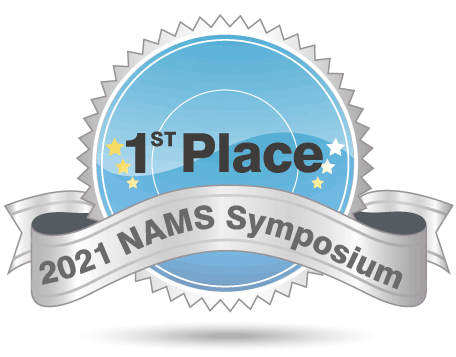
Kathleen Ngo '21
B.S. Biochemistry/Molecular Biology, B.S. Chemistry
Blue-shifted aggregation-induced emission enhancement (AIE) from fluorinated Sn hydroxyquinoline derivative complexes for organic light-emitting diode applications
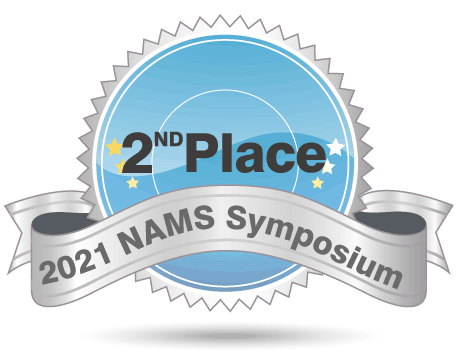
Matthew Mershon '21
B.S. Biology, Pre-Professional Studies, Minor in Chemistry
The Effects of Temperature on the Immune Performance of the Northern Red-Bellied Cooter (Pseudemys rubriventris)
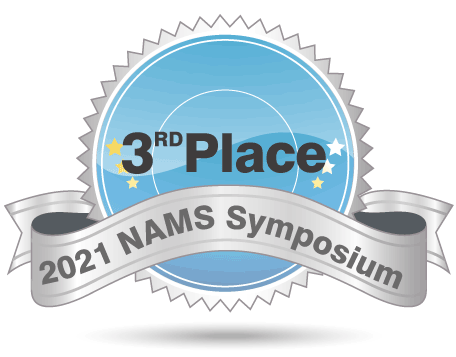
Cassandra Bennett '21
B.S. Geology
Inferring Forelimb Function in the Predatory Dinosaur Allosaurus
Danielle Marino, Samantha Brayton, and Anna Pfeiffer-Herbert
Estuary Bottom Type and Near-bed Velocities in Barnegat Bay
Jenna Horowitz, Lizbeilyn Ozoria, and Tara LH Luke
Use of eDNA to Characterize the Finfish Population of a NJ Coastal Dredge Hole
Ryder Lynch '22
B.S. Environmental Science, Forestry Concentration, Minor Women's, Gender and Sexuality Studies
Title: Investigating taxonomy and importance of macroinvertebrates in a cedar swamp environment
Abstract:
Macroinvertebrates are essential to our environment because they are good indicators of water quality and are beneficial to the ecosystem. The samples collected from Double Trouble State Park, Brendan T Byrne State Forest, and Stockton University contained dry and submerged soil. The samples were grouped into three dry samples and three wet samples and analyzed for macroinvertebrates. pH testing conducted in water and soil showed whether certain macroinvertebrates were more common in one area over another. Frequently occurring macroinvertebrates such as Acari (mites & ticks), Thysanoptera( thrips), Araneae (spider), and Hymenoptera (bees, wasps, sawflies & ants) were recorded, but other species' focus is preferred. Knowing that the average pH level for soil is 6.5-7.5 and the average pH level for water is 7.4, these factors were considered while surveying samples. Temperature and dissolved oxygen were recorded during the experiment to determine whether that would affect macroinvertebrates' results and variation. Litmus papers were used to test the water's pH in each area. The average amount of dissolved oxygen in a freshwater ecosystem is 6.5-8mg/L or 80-120%. The CHEMetrics K-7512 Dissolved Oxygen Kit was used to determine the dissolved oxygen level in each area. The water temperature was recorded by using a Neptonion Aquarium thermometer. This experiment's results can help stimulate a discussion on why macroinvertebrates are useful to our environment and further enhance education on the subject.
Research Website: https://www.ryderaverylynch.com/
Daniel Do '21
B.S. Biochemistry/Molecular Biology
Anastasia (Nastya) Morozova '21
B.S. Chemistry and B.S. Chemistry
Title: Synthesis and Characterization of Spin Coated and Inverse Opal Structured Transition Metal Dichalcogenide Thin Film Semiconductors
Abstract:
The development of efficient and cost-effective semiconductor thin film materials to replace precious metals for the application of photocatalysis is of intense research focus. Transition metal dichalcogenides are becoming an increasingly attractive candidate due to their tunable optical and electrical properties. However, conventional thin film fabrication methods can be quite costly and cumbersome. Herein we developed a highly accessible and facile solution-based method for developing device quality molybdenum disulfide (MoS2) and tungsten disulfide (WS2) semiconductor thin films using molecular precursors through a spin-coating technique. In addition, we fabricated templates of close-packed hexagonal polystyrene microspheres (500 nm) to create inverse opal structured MoS2 and WS2 semiconductors. Structural, optical, and electrical properties of the thin films were characterized by powder X-ray diffraction (PXRD), UV-Vis spectroscopy, and four-point probe, respectively. PXRD shows a clear transition from amorphous to crystalline structure between annealing temperatures of 300-500 °C. The MoS2 and WS2 thin films exhibited bandgaps of 1.55 ± 0.06 eV and 1.80 ± 0.10 eV, respectively, which are suitable for photocatalysis. Four-point probe measurements exhibited that as the annealing temperature increases, the resistance also increases. We also investigated the electrical and optical properties of Co and Ni-doped MoS2 semiconductors. Doping lowered the bandgaps slightly, and Ni-doped MoS2 films showed a decrease in resistance; however, Co-doped films had a slightly higher resistance compared to undoped MoS2 films. Preliminary cyclic voltammetry measurements show promise for hydrogen evolution. These protocols provide viable routes for producing thin films and nanoporous templates without requiring expensive equipment and extreme conditions.
Research Website: https://drkithinfilms.wixsite.com/drkithinfilm
Maha Malik '21
B.S. Biology, Pre-Professional Studies Concentration, Minor in Chemistry
Title:Ruthenium Complexes of Primary Amido-Functionalized N-Heterocyclic Carbenes
Abstract:
Transition metal complexes have been utilized as catalysts for transfer hydrogenation of ketones, a reaction important in chemical synthesis and pharmaceuticals. In this reaction, hydrogen donors instead of hydrogen gas can be used to reduce ketones and other functional groups. Most catalysts require an inert atmosphere and the addition of base. In this project, progress has been made to synthesize and characterize primary amido-functionalized N-heterocyclic carbene (NHC) ligands complexed to ruthenium for base-free transfer hydrogenation under aerobic conditions. Exploring different approaches of synthesizing the ruthenium complexes had varying degrees of success. While spectroscopic evidence suggests the desired complexes have been successfully synthesized, elemental analysis data suggest complexes that are not analytically pure. Future work is focused on exploring different reaction conditions to isolate analytically pure catalysts for transfer hydrogenation. Once pure ruthenium complexes are obtained, the next phase will be to evaluate their abilities for base-free transfer hydrogenation under aerobic conditions.
Research Website: https://malikm163.wixsite.com/my-site
Matthew Mershon '21
B.S. Biology, Pre-Professional Studies Concentration, Minor in Chemistry
Title:The Effects of Temperature on the Immune Performance of the Northern Red-Bellied Cooter (Pseudemys rubriventris)
Abstract:
With the continued emergence of new wildlife diseases, understanding the immune system of wildlife has become an increasingly important task. Unfortunately, most modern immune research focuses on birds and mammals, leaving the immune function of ectotherms a field that demands more attention. Because of this bias towards endotherms that regulate their own body temperature, we specifically lack information about how body temperature affects immune performance. Climate change and the reliance of ectotherms on temperature for biochemical reactions make studying this relationship between thermal performance and immune function a worthwhile contribution to the existing literature. The goal of this experiment was to add to this collective knowledge of reptile immune function by analyzing how temperature affects in vitro innate immune performance in the Northern Red-Bellied Cooter (Pseudemys rubriventris). We hypothesized that turtles would perform better at moderate temperatures between 30°C and 40°C and would not respond as well at more extreme temperatures. To accomplish this, turtles at Lake Fred were hand-captured and had a blood sample taken. An immune assay was performed on the isolated plasma samples to assess the ability of the turtles’ plasma to kill a gram-negative bacterium, E. coli, at a range of temperatures (15-45°C). A thermal performance curve was generated for each turtle, and a repeated measures ANOVA test was performed to identify differences in bactericidal ability at different temperatures. The results showed a significant effect of temperature on immune performance, with a mean optimal performance temperature of 32.8°C and an 80% performance breadth ranging from 25.2-40.4°C.
Research Website: https://mershon2.wixsite.com/namspresentation
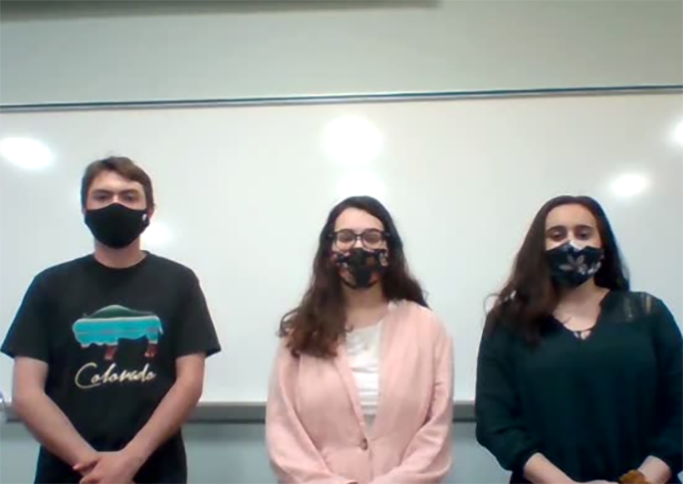
Ryan Hegarty '21
B.S. Environmental Science, Soil Science and Hyrdology Concentration
Katie Homewood '21
B.S. Environmental Science
Carel Abboud '21
B.S. Environmental Science, Soil Science and Hydrology Concentration
Title: Tapping into red maples (Acer rubrum): Baseline analysis of soil and litter parameters in Southern New Jersey
Abstract:
Southern New Jersey is not currently known for its maple syrup industry, due to low predominance of sugar maples (Acer Saccharum) and environmental factors that promote sap flow. Red maples (Acer rubrum), however, are an underexploited, tappable resource not traditionally tapped due to lower sugar content. This work aims to examine the feasibility of tapping A. rubrum in Southern NJ, the impacts soil parameters have on sap production, whether sap and environmental parameters relationships exist and differ across Southern NJ, and if tapping influences environmental parameters. Soil and litter were sampled from 1x1 m quadrats around A. rubrum from 6 sites in Southern NJ (inner and outer coastal plain). GIS maps were created for each site. Soil properties that influence vegetation were examined, including soil pH, total calcium, total organic carbon, bulk density, and particle size. Soil pH was determined using a pH meter. Aqua regia digestion was used to extract soil calcium and was analyzed using flame atomic absorption spectroscopy. Total organic carbon was determined through loss on ignition using a muffle furnace. Bulk density was determined using core samples collected with a bulk density hammer. Sand percentages were identified from sieved samples collected using a sieve shaker, and clays and silts were determined using the hydrometer method. Invertebrates were extracted from litter using Berlese funnels and identified and counted using optical microscopes in order to examine influences from tapping. Our initial findings suggest soil properties differ across Southern NJ and may ultimately influence syrup production and ecosystem sustainability.
Research Website: https://ryanhegarty13.wixsite.com/namssymposium
Cassandra Bennett '21
B.S. Geology
Title: Inferring Forelimb Function in the Predatory Dinosaur Allosaurus
Abstract:
Allosaurus was a large (10-12 m) bipedal theropod dinosaur from the Late Jurassic of North America. Although previous studies have explored how Allosaurus preyed upon herbivorous dinosaurs, understanding the function of its relatively small yet robust forelimbs remains challenging. We chose to study how the dimensions of the Allosaurus humerus compare to those of American alligators and of domestic turkeys, two extant archosaurs that bracket Dinosauria. As birds are more closely related to theropods, we hypothesized the dimensions of the humerus would be more similar between Allosaurus and the turkey as compared to the alligator. For all archosaurs in our sample, our data show that humerus robustness (length v. circumference) and deltopectoral crest length scale with positive allometry. This suggests that as the humerus lengthens, the deltopectoral crest extends relatively further away from the shoulder, indicating a relatively higher mechanical advantage for muscles associated with protraction and adduction coupled with a lower range of motion. In contrast, the medial condyle compared to the lateral condyle showed negative allometry; because the medial condyle is associated with flexor muscles, this would indicate the mechanical advantage of manus flexion decreases in larger animals. In all of these instances, Allosaurus humeri scaled like those of alligators compared with the turkeys. Therefore, we reject our hypothesis and suggest Allosaurus likely had a range of forelimb movement similar to alligators. This would preclude the ability of Allosaurus to have a predatory forelimb stroke hypothesized for bird-like theropods.
Research Website: https://bennet66.wixsite.com/allosaurusforelimb
Dorothy Missimer '21
B.S. Criminal Justice, Forensic Investigation, Minor in Anthropology
Title: Forensic Individualization of Unknown Human Skulls
Abstract:
In Forensic Anthropology, the identification and individualization of skeletonized remains is important and includes the identification of an individual’s sex, age, and ancestry. Over the years, Stockton has received various skulls through donations. In an effort to gain more information, this study examined and measured these skulls. Initial non-metric examination was used to create a hypothesis about the sex, age, and ancestry of the skulls. Measurements were taken to test the hypothesis. The measurements were then entered into a statistical database, ForDisc 3.1, that uses discriminant function analyses (DFA) to evaluate the unknown remains’ sex and ancestry. For this study, three human skulls were examined. Skull A was hypothesized to be an African American female. This skull has more gracile and feminine features. ForDisc supported this hypothesis (81.8% probability). Skull B was hypothesized to be a male of mixed ancestry. This skull’s features are robust; it has a prominent brow ridge and occipital protuberance. Malar tubercles are present; this feature is most commonly found in people of Asian or Indigenous American ancestry. ForDisc results indicate that the measurements are too dissimilar in all ancestral categories. In the DFA graph, Skull B appears in three overlapping categories: White, African American, and Indigenous American. Skull C is believed to be an African American male. This skull features more robust features, like large mastoid processes and a large mandible. When measurements were entered into ForDisc, the category of African American male had the highest probability (62.2%) supporting the hypothesized sex and ancestry.
Research Website: https://missimed.wixsite.com/namssymposium
Jenna Horowitz '21
B.S. Biology, Biotechnology Concentration, Minor in Mathematics
Lizbeilyn Ozoria '21
B.S. Biochemistry/Molecular Biology, Minor in Spanish and Behavior Neuroscience
Principle Investigator: Tara LH Luke
Title: Use of eDNA to Characterize the Finfish Population of a NJ Coastal Dredge Hole
Abstract:
As part of a larger ecosystem characterization of finfish usage, this study uses environmental
DNA (eDNA) data to help characterize the faunal community of Dredge Hole #90 in Atlantic
County. Water samples containing eDNA were collected in the spring, summer, and autumn
of 2020, filtered, and frozen for future analysis. Complete genomic DNA was extracted
from these samples, which were then processed in order to perform next generation
amplicon sequencing using a well-characterized region of the mitochondrial rRNA for
which many local finfish species have previously been added to DNA sequence databases.
DNA sequences, including those extracted from Genbank were aligned and analyzed using
Molecular Evolutionary Genetics Analysis (MEGA-X) software. The genetic sequences
of the unknown samples were compared to previously identified bony and cartilaginous
fish samples to determine the species that were present in the dredged hole. MEGA-X
was also used to perform phylogenetic analyses and build phylogenetic trees in order
to identify fauna present at the study site. Data will be ground-truthed with results
collected via traditional survey methods, and could potentially result in a less-invasive
method for identifying faunal use of an ecosystem that is not dependent on invasive
sampling techniques.
Research Website: https://taraluke.wixsite.com/horowitz-ozoria-nams
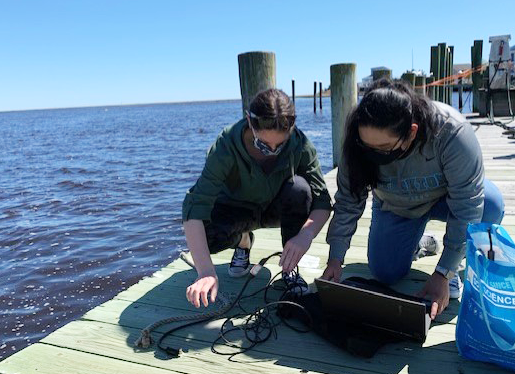
Felicity Do '21
B.S. Chemistry, American Chemical Society Concentration, Minor in Holocaust and Genocide Studies
Caitlyn Fogarty '21
B.S. Chemistry
Title: Coastal Biogeochemistry: Understanding the Coastal Carbon Cycle
Abstract:
The carbon cycle is a process that helps control the fluctuations of the climate of
the Earth. Rising atmospheric carbon dioxide (CO2) emissions due to the burning of
fossil fuels have negatively impacted the global carbon cycle. In aquatic ecosystems,
rising CO2 is leading to ocean acidification (a decrease in pH). In this work, field
sensors for pH and CO2 were used to measure carbonate parameters at three sites in
coastal NJ waters. This data can give us a better understanding of inorganic carbon
cycling in aquatic coastal ecosystems and the impacts of current and future changes.
The three field sites currently have sensors for physical parameters, lower accuracy
pH, and pCO2. Data from 2017-2020 have been analyzed through the compilation of a
series of pH vs temp, DO% vs pH, and salinity vs temp graphs to examine the variability
and determine what is driving changes at these sites. In addition, high accuracy pH
sensors are being prepared for deployment at all three sites during the Spring and
Summer 2021 field seasons.
Research Website: https://dof862.wixsite.com/coastal-carbon-cycle
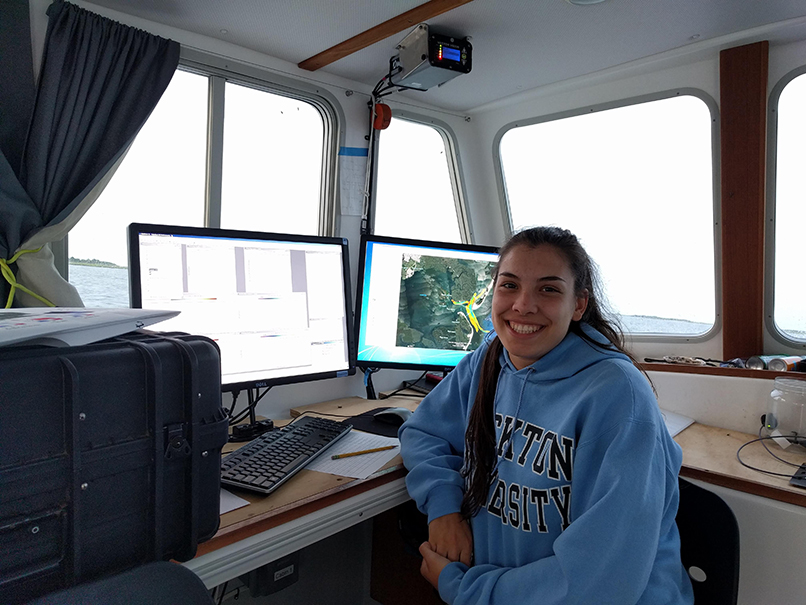
Danielle Marino '21
B.A. Communications Studies, Public Relations Concentration, Minor in Marine Science
Samantha Brayton '21
B.S. Marine Science, Marine Biology Concentration
Principle Investigator: Anna Pfeiffer-Herbert
Title: Estuary Bottom Type and Near-bed Velocities in Barnegat Bay
Abstract:
An estuary’s bottom type influences the water flow speeds within the bottom boundary layer of water above the seabed. The water movement in this layer aids in transporting sediment, larvae, and dissolved substances such as oxygen. For example, larger near-bottom flow speeds will lead to more sediment erosion. Tilt Current Meters, or TCMs, allow us to make measurements regarding differences in bottom velocities. TCM instruments were deployed with water level sensors at three sampling sites of varying bottom types (bare, vegetated, and within aquaculture gear) within Barnegat Bay, New Jersey. Data collection occurred in two week periods during the months of March and October 2020. We expected to find the highest near-bed velocities at sampling sites with a bare bottom and the lowest velocities within oyster aquaculture gear due to disruption of the bottom boundary layer flow by the gear. TCM data demonstrated fastest current speeds at the bare bottom site and slowest speeds near the oyster aquaculture, as anticipated. Based on relationships between current speed and sediment erosion, the aquaculture gear site would experience more deposition of sediment and less erosion compared to the bare or vegetated sites. Increased deposition allows for the settlement of sediment and other particulate matter such as seagrass seeds, which would further impact estuary bottom type and near-bed velocities.
Research Website: https://marinod5.wixsite.com/nams2021
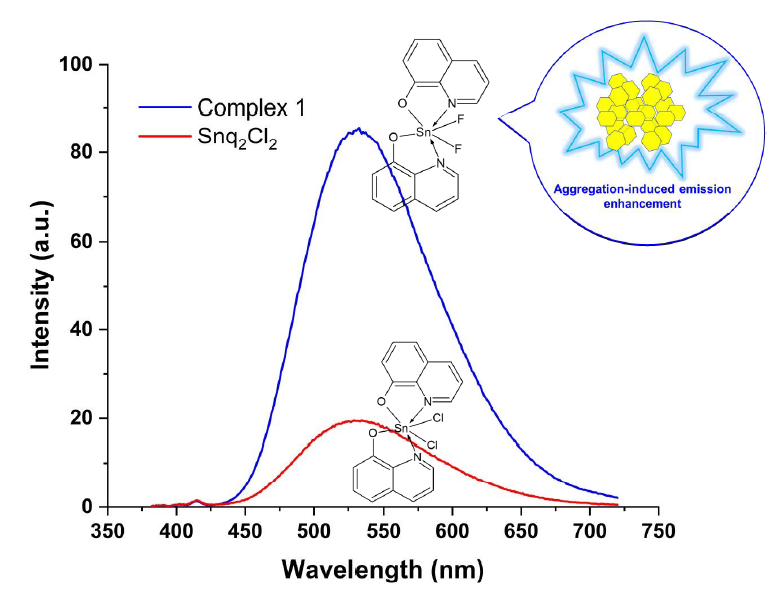
Kathleen Ngo '21
B.S. Biochemistry/Molecular Biology, B.S. Chemistry
Title: Blue-shifted aggregation-induced emission enhancement (AIE) from fluorinated Sn hydroxyquinoline
derivative complexes for organic light-emitting diode applications
Abstract:
Aggregation-induced emission enhancement (AIE), emission enhancement upon aggregate formation arising from the restriction of intramolecular rotation and vibration, has been observed in many organic materials. This AIE property is advantageous over the more commonly observed aggregation caused quenching (ACQ) for organic light-emitting diodes (OLEDs), which rely on solid-state materials in the emitting layer. ACQ phenomenon has been a critical issue in limiting the efficiency of OLEDs. Herein, we present the synthesis of Sn(IV) complexes from 8-hydroxyquinoline (q) and 5,7-dimethyl-8-quinolinol (me2q) and examine structural, optical, thermal and AIE properties for OLED applications. For Snq2X2 and Sn(me2q)2X2 (X=F, Cl), a unique halide exchange from Cl to F was achieved through fluoride ion, a degradation product of hexafluorophosphate, complexing the Sn center and replacing Cl. The fluorinated Sn complex produces significantly improved thermal stability and quantum efficiency for Snq2X2. Single crystallographic data and cyclic voltammetry reveal such phenomena are attributed to stronger σ bonding interaction between Sn and F, however both F and Cl versions of Sn(me2q)2X2 show identical relative quantum yields (ΦPL, solution=0.5%). Interestingly, Snq2F2 shows significant AIE properties (ΦPL, solid=17%) while Snq2Cl2 does not, but both the Cl and F versions of Sn(me2q)2X2 display moderate AIE properties (ΦPL, solid=4% and 6% for Sn(me2q)2F2 and Sn(me2q)2Cl2, respectively).
Research Website: https://ngok11.wixsite.com/snaiephosphors

Timothy Freudenrich '21
B.S. Chemistry, American Chemical Society Concentration, Minor in Biology
Title: Development of a Cost-Effective Method for MBT Detection in Beer
Abstract:
3-methyl-2-butene-1-thiol (MBT) is a common side product in the brewing of beer that produces undesirable flavors at concentrations of parts per trillion. Detection of MBT by large-scale breweries is traditionally performed using gas chromatography, but a less expensive spectrophotometric method has been investigated for use by microbreweries involving the use of a chromene derivative as a probe. Solutions containing MBT were mixed with the probe and observed with UV/Vis spectroscopy, and reduction in the probe's characteristic absorbance peak was recorded. It was determined that the chromene probe is able to detect the presence of MBT in solution at concentrations of parts per million. An extraction method for beer was also investigated to allow any MBT present to be analyzed with the new method. Further research is required to optimize the detection method to allow detection of MBT at concentrations of parts per trillion, and to determine the efficacy of the probe in extractions from spiked samples of beer.
Research Website: https://freudent2.wixsite.com/nams-symposium
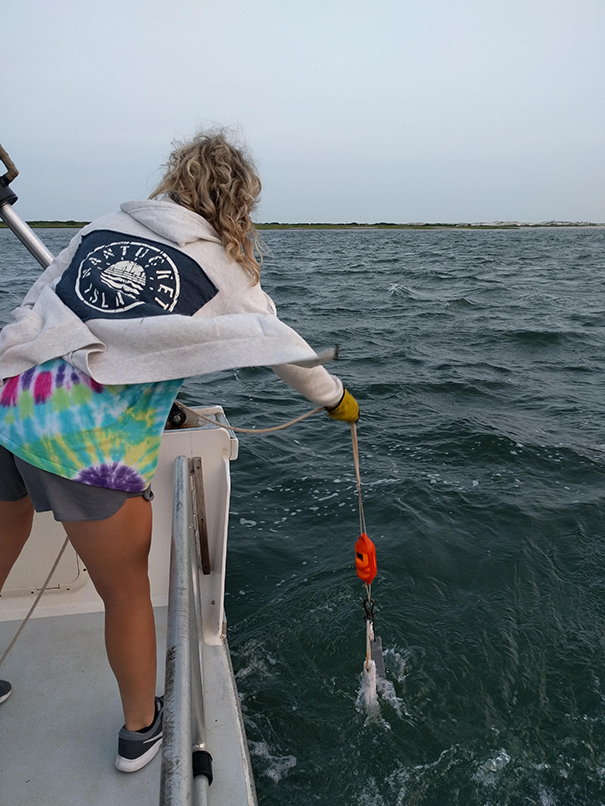
Samantha Hughes '22
B.S. Marine Science, Oceanography Concentration
Haley Green '22
B.S. Marine Science, Oceanography Concentration, Minor in Chemistry
Principle Investigator: Anna Pfeiffer-Herbert
Title: The influence of a dredge hole on tidal asymmetry and salinity structure in the Mullica
River estuary
Abstract:
Estuarine salinity and velocity patterns are controlled by freshwater input, tides,
and bottom topography. Artificially deepening estuary channels through dredging modifies
water column stratification and tidal currents. We examined these processes in a 15-meter
deep dredged hole near Chestnut Neck, within the Mullica River estuary. Data were
collected during two vessel-based Acoustic Doppler Current Profiler (ADCP) surveys
with intermittent Conductivity-Temperature Depth (CTD) casts in and adjacent to the
Chestnut Neck dredge hole. A stationary ADCP was placed within the hole during the
vessel surveys. Analysis of stationary ADCP data yielded a semidiurnal tidal current
amplitude of 0.45 m s-1 near the surface that diminished to 0.16 m s-1 near the bottom
of the dredge hole. In contrast, data previously collected downstream of the dredge
hole showed uniform amplitudes of ~0.4 m s-1 for both near surface and near bottom
currents. The near-bottom velocities were highly asymmetrical (0.4 m s-1 at maximum
flood and 0.1 m s-1 at maximum ebb tide), potentially trapping higher salinity water
in the dredge hole during ebb tide. ADCP transects confirm the ebb velocity asymmetry
and its restriction to the dredge hole. CTD salinity profiles revealed that the vertical
salinity gradient varied with tide stage between 0.07 to 0.24 psu m-1. During ebb
tide, the dredge hole developed a higher salinity layer coinciding with the weak ebb
velocities. Trapping of high salinity waters within the dredge hole appears to alter
the water column salinity structure and tidal flow, potentially impacting the local
benthic environment.
Research Website: https://greenh29.wixsite.com/website
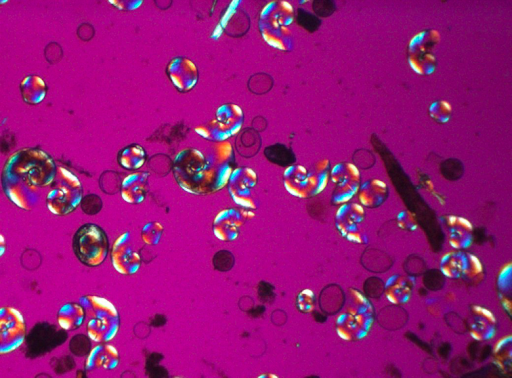
Kenichi Hirose '21
B.S. Marine Science, Marine Biology Concentration
Liam Abrams '21
B.S. Marine Science, Marine Biology Concentration, Minor in Biology
Title: Spatial and temporal variation of larval and spatfall index of the Eastern oyster
(Crassostrea virginica) in the Mullica River Estuary
Abstract:
The relationship between juvenile oysters (spat) and larvae are important in understanding
the overall sustainability of oyster populations. In this project, spatial and temporal
variability of eastern oyster (Crassostrea virginica) spat were assessed from 2017-2019
in the Mullica River and correlated to oyster larval samples. Oyster spat samples
covered four sites in the Mullica River upstream from its mouth at the Great Bay estuary.
Oyster spat were sampled biweekly in July and August from 2017-2019. Site and sampling
date differences each year were analyzed using a two-factor ANOVA. Significance was
determined by the Tukey pairwise comparisons with a 95% confidence. The sampling dates
for each year showed significant variation, most years showing the highest spatfall
in mid-July. Spatial variation showed the Akimbo site having significantly higher
spatfall for 2017 and 2018. In 2019, Swan Point (furthest upriver) and Fitney Bit
(furthest downriver) showed significant differences in spatfall from central river
sites French's Point and Akimbo. Plankton samples were obtained on similar spatial
and temporal scales, and bivalve larvae from these samples were imaged under a polarized
microscope. Bivalves were extracted from images using MATLAB software and sorted into
groups representing small oyster larvae (D-stage), larger oysters (veligers) and non-oysters.
We compared oyster larval abundance to the total spat settlement index each year for
the most downstream site, Fitney Bit. Correlating oyster larvae with spatfall allows
us to understand the interannual variability between life stages in oyster populations,
which is important for managing this commercially important resource in the Mullica
River.
Research Website: https://hirosek1.wixsite.com/mullica-river-spat
Usama Chaudhri '21
B.S. Marine Science, Marine Biology Concentration
Lana Mena '21
B.S. Marine Science, Marine Biology Concentration
Samantha Brayton '21
B.S. Marine Science, Marine Biology Concentration
Emily Sheridan '21
B.S. Marine Science, Marine Biology Concentration
Natalie Cooper '23
B.S. Biology, Pre-Professional Studies Concentration, Minor in Marine Science
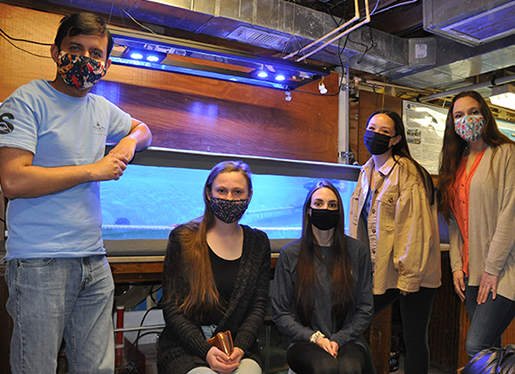
Title: The Coral Farm
Abstract:
Coral aquaculture and the reef aquarium industry in general are multi-billion-dollar
industries. With certain export bans on corals from places such as Fiji and Hawaii,
the demand for aquacultured coral has increased exponentially over the years. Culturing
and husbandry of coral has allowed for advances in coral restoration projects and
research on coral biology in relation to climate change without affecting wild populations.
This project highlights the process of propagating coral and allows for further research
projects to be involved in understanding these organisms. Building the aquacultured
coral farm encompassed many important processes including water chemistry, filtration,
lighting, and the coral fragging procedure. Understanding these key elements are essential
for proper care of corals. Water and light parameters are measured and adjusted to
mimic natural oceanic conditions that are ideal for coral growth. Corals are added
to the aquarium as fragments from mother colonies and are given time to grow more
polyps. Throughout this development, these fragments, also referred to as "frags",
will be moved to colonize in other systems. Corals from the main frag tank can be
used for scientific research and experiments, be sold to hobbyists, added to exhibits,
or used in outreach programs. The creation of this farm and understanding the biological
and chemical aspects of aquaculture allows our club members, faculty, and students
to learn about and research coral biology, husbandry, aquaculture, and conservation.
Research Website: https://chaudhru0.wixsite.com/thecoralfarm
Abigail Hartman '21
B.S. Environmental Science, Soil Science and Hydrology Concentration, Minor in Chemistry
Principle Investigator: Dr. Jessica Hallagan
Title: Trace Metal Bioavailability in New Jersey Vineyard Soils
Abstract:
New Jersey houses a burgeoning vineyard industry due to its acidic and well-drained soils. It is currently the seventh-leading domestic wine producing state in the American Viticulture Area. Unfortunately, many vineyards are at risk of trace metal contamination due to their proximity to major roadways. Metals commonly sourced from vehicle emissions, roadway materials, and storm water runoff can easily mobilize through well-drained soils. This work focuses on lead (Pb), a common contaminant found in roadway soils and factors that influence its bioavailability to grapevines (Vitis vinifera). Typically, Pb is adsorbed onto soils and tightly held for long durations. However, phosphate fertilizers and other soil amendment additions can solubilize Pb and increase its bioavailability. Soil and grapes were sampled from linear transects established at a vineyard located in the NJ Pine Barrens neighboring a trafficked roadway. Soil samples were collected (depth: 0–20 cm) at 5 points located along transects: nearest to roadways, in between grapevines and roadways, and 3 points along rows of grapevines. Soluble Pb was extracted from soil samples using deionized water and samples were shaken. Grape samples were digested for Total Pb in nitric acid and analyzed using flame atomic absorption spectroscopy (FAAS). Simple linear regression was employed to identify a correlation between soil Pb content, roadway proximity, and grape Pb content. Future work will examine soil applications of material to sequester trace metals of concern.
Research Website: https://hartma51.wixsite.com/soils
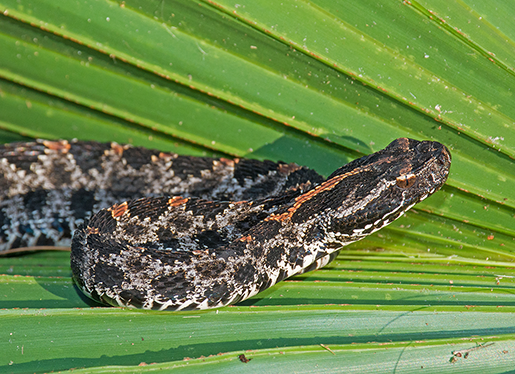
Kathryn McLaughlin '21
B.S. Biology, Pre-Professional Studies Concentration, Minro in Behavioral Neuroscience, Chemistry and Disability Studies
Nilanjana Das '21
B.S. Marine Science, Marine Biology Concentration
Title: Assessing effects of seasonal acclimation and adaptation on thermal performance of
immune function in ectothermic vertebrates
Abstract:
Thermal biologists often investigate the thermal properties of physiological processes
using thermal performance curves (TPCs). However, these studies have largely been
conducted on endothermic organisms which maintain stable, warm body temperatures,
and the effects of body temperature on critical physiological processes, like immune
function, have been understudied. In ectotherms, body temperature directly reflects
that of their environment, and physiological performance, from a molecular to whole
organism scale, is highly influenced by the temperatures they experience. Knowing
this, we posed two hypotheses: (1) TPCs for immune function would vary between summer
and winter- active ectotherms due to seasonal acclimation, and (2) TPCs would vary
between a subtropical (pygmy rattlesnake) and temperate (northern water snake) ectotherm
species, due to variation in thermal environments experienced at different latitudes.
To examine this, bacteria killing ability (BKA) assays were performed on two species
of snake to assess the function of complement proteins and natural antibodies in the
innate immune system when exposed to a gram negative bacterium, E.coli. Resulting
BKA scores were compared across a range of temperatures (10-45℃), after which nonlinear
curves were constructed to describe thermal performance of immune function in each
species and season. Results indicated that thermal effects on immune function were
different in summer compared to winter pygmy rattlesnakes. However, there was no statistical
support for the hypothesis that differences in latitude affect the thermal performance
of immune function. These results suggest that seasonal acclimation in the thermal
performance of immune processes should be explored further in future studies.
Research Website: https://mclaug782.wixsite.com/my-site?fbclid=IwAR38nxlvT_aT3me9pdfCde5PGEhSZBCVZIpwBh1cpbW7SeA7EsSiHy0hu1w
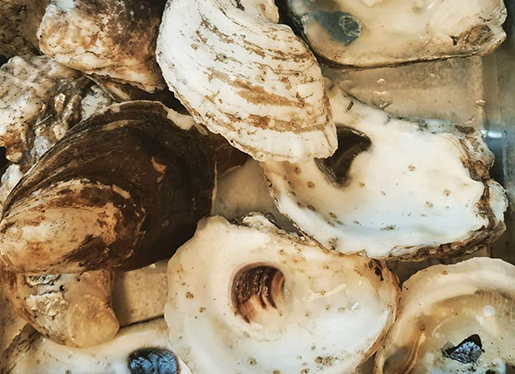
Matthew Leason '21
B.S. Marine Science, Marine Biology Concentration
Lauren Russnak '21
B.S. Marine Science, Marine Biology Concentration, Minor in Sustainabilty and Biology
Title:Environmental factors influencing annual Eastern oyster (Crassostrea virginica) spatfall in the Mullica River
Abstract:
Understanding relationships between water quality and marine organisms is important
for understanding how these populations respond to environmental changes. The eastern
oyster (Crassostrea virginica) goes through a larval and juvenile stage before reaching
maturity. The juvenile or “spat” phase occurs as larvae from the water column settle
onto a hard substrate and become fixed. The settlement of spat is affected by biotic
and abiotic factors such as temperature and salinity. We compared these factors to
annual spat settlement and recruitment indexes over a six year period (2014-2020).
Indexes were calculated from biweekly spat bags (settlement) as well as seasonal bags
(recruitment) from 10 sites within the Mullica River. Spat bags were deployed from
June to September each year. Water quality data was obtained from the Chestnut Neck
monitoring station within the Jacques Cousteau National Estuarine Research Reserve
System (JCNERRS) and averaged monthly and daily from May to September each year. We
compared the water quality data to the settlement and recruitment indexes using a
multiple regression. It was determined that the spat index was not affected by salinity,
however it was negatively affected by May temperature and positively affected July
and August temperature. The seasonal recruitment index was similarly negatively affected
by May temperature and positively influenced by June and August temperatures. Recruitment
indexes additionally were negatively affected by July temperature and salinity. This
suggests that temperature has a stronger influence over salinity in affecting oyster
population dynamics in the Mullica River through interannual variations in spatfall.
Research Website: https://russnakl.wixsite.com/namswaterquality

Colleen Lindenau '21
B.S. Applied Physics, B.S. Mathematics
Gracie Buondonno '22
B.S. Applied Physics, Minor in Mathematics, Music Studies
Principle Investigator: Joseph Trout
Title: Analysis and Comparison of Light Intensity Spectra Using Wavelet and Fourier Analysis
Abstract:
This poster demonstrates our research on analyzing the light intensity spectra of
stars with data provided by the Kepler Space Telescope. We analyzed the stellar light
curves using Fourier Analysis and Wavelet Analysis. Continuous data of the light spectra
intensities are used for the analysis of astronomical phenomena such as discovering
the orbit of previously unseen planets. We compared the time series of light intensities
recorded from a ground and space telescope. The time series data from a ground space
telescope is sometimes missing data, we are working towards a way to fill in the missing
data points by using data from land-based telescopes. This poster presents the comparison
of data collected and analyzed with Fourier Analysis and Wavelet analysis.
Research Website: https://lindenac.wixsite.com/nams-submission
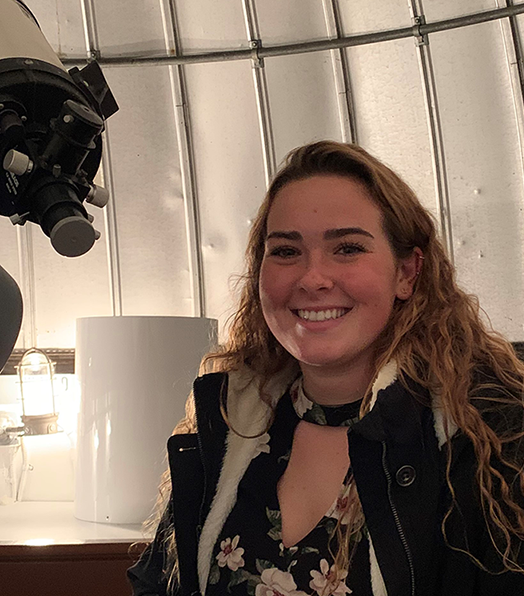
Courtney Weber '22
B.S. Biology, Pre-Professional Studies, Minor in Physics
Briena Feltner '21
B.S. Applied Physics
Principle Investigater: Joseph Trout
Title:Predicting the First and Last Frost using Historical Data and Numerical Weather Predictions
Abstract:
This poster demonstrates our research on analyzing the light intensity spectra of stars with data provided by the Kepler Space Telescope. We analyzed the stellar light curves using Fourier Analysis and Wavelet Analysis. Continuous data of the light spectra intensities are used for the analysis of astronomical phenomena such as discovering the orbit of previously unseen planets. We compared the time series of light intensities recorded from a ground and space telescope. The time series data from a ground space telescope is sometimes missing data, we are working towards a way to fill in the missing data points by using data from land-based telescopes. This poster presents the comparison of data collected and analyzed with Fourier Analysis and Wavelet analysis.
Research Website: https://weberc11.wixsite.com/urbanheateffect

Tara Jacobsen '21
B.S. Applied Physics, B.A. Teacher Education, Minor in Mathematics
Title: Astrophysics: History and Theory,’ an undergraduate, interdisciplinary, asynchronous Astrophysics course taught in the physics program
Abstract:
This project produced an online astronomy course based on the free, online OpenStax textbook. When this project was conceived, about a year before the Covid-19 pandemic, the authors had no idea that in a short period of time, most college and university classes would be online. This abrupt change in modalities of courses, from traditional, face-to-face lectures and laboratories to a more modern online format, sparked energetic discussions about the effectiveness of online courses. This paper describes the online astronomy course and its creation and evaluates the success of the course at conveying the concepts and theories studied in astronomy courses. The success of this course is examined using a 100-question pretest and posttest based on content knowledge. A survey was also completed of the students to evaluate the perceived success of the online course and the acceptance of online courses. The survey was adjusted to include opinions about the in-person labs which were cancelled due to the Covid-19 pandemic.
Research Website: https://jacobse1.wixsite.com/astrophysics


